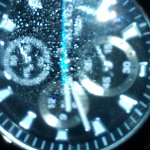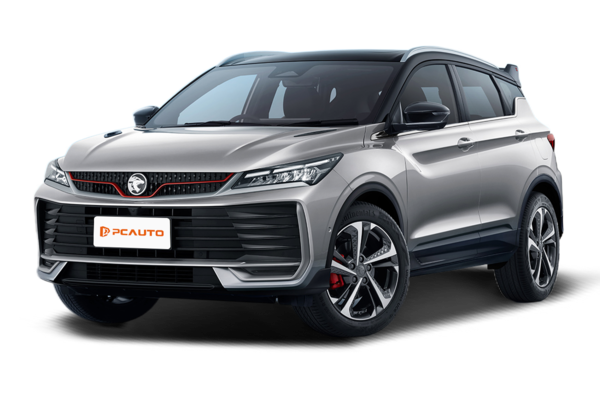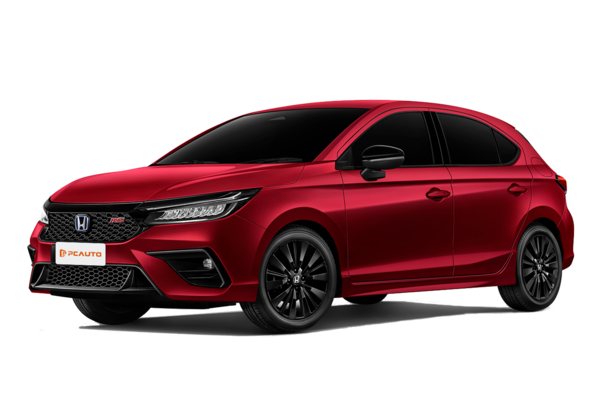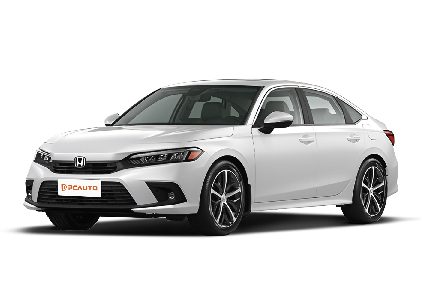Q
What is the Engine in Honda Jazz?
The Honda Jazz available in the Malaysian market is equipped with a 1.5-liter i-VTEC naturally aspirated gasoline engine. This engine is well - known for its high efficiency and reliability. It has a maximum output power of approximately 120 horsepower and a peak torque of 145 Nm, making it suitable for city driving and daily commuting while also taking fuel economy into account.
This engine adopts Honda's classic i-VTEC technology, which optimizes power output and fuel consumption through an intelligent variable valve timing and lift system. Paired with a CVT continuously variable transmission, it offers a smooth driving experience.
In addition, the Honda Jazz also comes in a hybrid version (such as the e:HEV). It combines a 1.5-liter Atkinson cycle engine with a dual - motor system, further enhancing energy - saving efficiency, which is ideal for consumers with higher environmental protection requirements.
For Malaysian users, the durability and low maintenance cost of this engine are also among the reasons for its popularity. Moreover, Honda's after - sales service network covers the whole country, providing convenience for car owners. When it comes to the used - car market, the engine of the Jazz also has a relatively high resale value, making it an economical and practical choice.
Special Disclaimer: This content is published by users and does not represent the views or position of PCauto.
Popular Models
Related Q&A
Q
What Segment is Honda Jazz?
The Honda Jazz is classified as a B-Segment small hatchback in the Malaysian market. This segment is typically characterized by flexible handling, economic practicality, and convenience for urban commuting, making it suitable for Malaysia's narrow streets and high fuel costs. The Jazz has become a popular choice in this segment, especially among young families and urban commuters, thanks to its iconic "Magic Seat" flexible seating design, efficient Earth Dreams engine technology, and spacious interior within a compact body.
In the Malaysian market, competing models in the same segment include the Toyota Yaris and Perodua Myvi. However, the Jazz is well - known for the high resale value and reliability of the Honda brand. It's worth noting that B - Segment vehicles in the Southeast Asian market generally prioritize fuel economy and maintenance costs. The combination of the Jazz's 1.5L i - VTEC engine and CVT transmission can achieve an actual fuel consumption of over 15 km/L, meeting the local consumers' demand for practicality.
In addition, this vehicle line was upgraded to a hybrid version in some global markets in 2021. However, the current models in Malaysia still mainly use traditional fuel power. Whether a new energy version will be introduced in the future depends on Honda's regional strategic adjustments.
Q
What is the Reslae Value of Honda Jazz?
The resale value of the Honda Jazz in the Malaysian used - car market is relatively stable. This is due to its reliable quality, low fuel consumption, and the high local recognition of the Honda brand. Depending on the vehicle's age, mileage, and condition, a 3 - to 5 - year - old Jazz can usually retain 50% - 65% of its original price. The Hybrid models may have a 5% - 8% premium because of their energy - saving features.
The key factors affecting its residual value include regular maintenance records (especially the maintenance of the CVT transmission), the body color (white and silver are more popular), and whether it is still within the original factory warranty period. It is recommended that car owners keep complete maintenance receipts and use original factory parts to maximize the vehicle's value retention.
Among its peers, the used - car price performance of the Jazz is better than some of its competitors. This is related to its flexible space design (such as the ULTRA seat system) and low failure rate. However, the specific transaction price still needs to refer to the real - time data on used - car platforms like Carlist or mytukar.
It's worth noting that the tax - exemption policy for domestic cars introduced in some regions after 2020 has slightly affected the price fluctuations of imported used cars. But as a cost - effective urban vehicle, the demand for the Jazz remains strong in urban areas like the Klang Valley.
Q
How Many CC is Honda Jazz?
The Honda Jazz models available in the Malaysian market are mainly equipped with a 1.5 - liter naturally aspirated engine with a displacement of 1497cc (cubic centimeters). This is a common 'golden displacement' for compact hatchbacks, balancing fuel economy and power performance. This engine uses Honda's i - VTEC technology, capable of outputting approximately 120 horsepower and 145 Nm of torque. It is paired with a CVT transmission or a 6 - speed manual transmission (depending on the version), which is suitable for urban commuting and flexible driving.
It's worth noting that while the displacement (CC) affects power output, the actual driving experience also depends on engine tuning, vehicle weight, and the matching of the transmission system. For example, Honda has optimized the combustion efficiency of the Jazz through Earth Dreams technology, making the torque more abundant at low speeds. Malaysian customers can also pay attention to the minor changes in different model years when making a choice. For instance, some versions after 2020 have upgraded the Honda SENSING safety system.
Similar models in the same class, such as the Toyota Yaris or Perodua Myvi, also use a similar displacement, but they have different technological focuses. It is recommended to take test drives for comparison. Additionally, Malaysia's automotive tax structure gives vehicles with a displacement below 1.5 liters a price advantage, which is also one of the reasons why the Jazz has been popular for a long time.
Q
What is the Gearbox Type of Honda Jazz?
The transmission types vary among different versions of the Honda Jazz. Specifically, the 2019 Honda Jazz 1.5 S, 1.5 E, and 1.5 V versions all come with a CVT (Continuously Variable Transmission). This type of transmission offers a smooth shifting experience, making the driving process even more seamless and also helping to improve fuel efficiency.
On the other hand, the 2019 Honda Jazz 1.5 Hybrid version is equipped with a DCT (Dual-Clutch Transmission). A dual-clutch transmission allows for rapid gear changes and highly efficient power transfer, which can enhance the vehicle's dynamic performance and driving pleasure to some extent.
Each type of transmission has its own unique features. Consumers can choose the appropriate model according to their driving habits and needs.
Q
What is the PCD Size of Honda Jazz?
The PCD (Pitch Circle Diameter) size of the Honda Jazz is 4x100, which means its wheels have 4 bolt holes, and the centers of these holes are distributed on a circle with a diameter of 100 millimeters. This specification is very common in the Malaysian market and is suitable for many economy and compact cars. Understanding the PCD size is crucial when replacing wheels or upgrading tires because if the PCD doesn't match, the wheels won't be installed correctly, which may affect driving safety.
Apart from the PCD, when choosing wheels, you also need to pay attention to the center bore diameter (CB) and the offset value (ET) to ensure full compatibility. Owners of the Honda Jazz can choose factory - spec wheels or wheels from other brands that meet the 4x100 PCD when modifying their wheels. However, it is recommended to choose certified products to ensure quality and safety.
In addition, when modifying wheels, you need to pay attention to the traffic regulations in Malaysia to ensure that the modified vehicle meets local standards and avoid penalties for violations.
Q
Does Honda Jazz Support Apple Carplay?
Yes, some models of the Honda Jazz in Malaysia are indeed equipped with Apple CarPlay, especially the higher - spec versions like the Honda Jazz RS or Honda Jazz Hybrid. These models usually come with a touch - screen infotainment system that's compatible with Apple CarPlay. This allows users to connect their iPhones via a data cable and use functions such as navigation, music, and making calls. It's important to note that there might be differences in Jazz models of different years and configurations. It's recommended to confirm the specific features with the dealer before purchasing. The addition of Apple CarPlay significantly enhances driving convenience, enabling users to use common phone functions more safely without having to take their eyes off the road to operate their phones.
Moreover, the Honda Jazz is well - loved by Malaysian users for its flexible interior space design and fuel efficiency. It's ideal for city commuting and small families. If you have high requirements for in - car connectivity features, you can also look into similar configurations of other models in the same class, such as the Toyota Yaris or Mazda 2, to make a more suitable choice.
Q
What is the Tyre Brand of Honda Jazz?
The original-equipment tire brands for the Honda Jazz in the Malaysian market may vary depending on the model year and configuration. Common tire - supplying brands include mainstream manufacturers such as Dunlop, Yokohama, or Bridgestone. These brands are well-known for their wear resistance and wet - surface performance, which meet the requirements of the rainy climate in Southeast Asia. Car owners can confirm the specific tire model through the sidewall markings or the user manual. For example, the Dunlop ENASAVE EC300+ is a common choice for high-efficiency and energy-saving tires in recent years.
It's worth noting that since tires are consumable items, when replacing them, in addition to the original-factory specifications, you can also consider silent and comfortable products like the Michelin Primacy 4 or the Continental UC6. However, you must ensure that the size (such as 185/55 R16), load index, and speed rating meet the matching requirements of the Jazz's suspension setup and ABS system.
Regularly checking the tire pressure (it is recommended to do it once a month) and wheel alignment can extend the tire life. Especially on the high-temperature roads in Malaysia, the rubber ages more quickly. If the tread depth is found to be less than 1.6 millimeters, you should replace the tires immediately to comply with JPJ regulations.
Q
Is Honda Jazz a Good Car? Learn the Pros and Cons Here!
The Honda Jazz is a highly favored small hatchback in Malaysia. Its advantages include a flexible body size that is suitable for city driving, and it offers economical fuel consumption. The 1.5-liter i-VTEC engine it is equipped with provides smooth and reliable power. The interior space is cleverly designed. In particular, the "Magic Seats" allow for flexible adjustment of the storage space, making it suitable for families or young consumers. Moreover, the Honda brand has an extensive after-sales service network in Malaysia, making maintenance relatively convenient.
However, it does have some drawbacks. Its sound insulation is average, and wind noise is quite obvious when driving at high speeds. The rear suspension is tuned to be on the stiffer side, which affects comfort to some extent. Also, its configuration may not be as rich as that of its competitors in the same class.
For buyers with a limited budget who value practicality and brand reliability, the Jazz is a worthy option to consider. But if you're looking for higher comfort or more advanced technological features, you may need to compare other models.
In Malaysia's hot and rainy climate, it is recommended to regularly check the air-conditioning system and the anti-rust condition of the chassis to extend the vehicle's lifespan.
Q
What is the Width of Honda Jazz?
The body width of the Honda Jazz is 1,694 millimeters. This dimension is considered moderate among the common city compact cars in Malaysia. It can ensure that the interior lateral space is sufficient for three adults to sit comfortably, and at the same time, it can also flexibly maneuver through the narrow streets of Kuala Lumpur or the old shopping mall parking lots. As a global strategic model of Honda, the compact body design of the Jazz is particularly suitable for the winding mountain roads and congested urban roads in Malaysia. The MM concept (minimizing the mechanical space and maximizing the interior space) it adopts enables the 1,694-millimeter body width to achieve a class - leading interior space utilization rate. The magic seats in the rear can be folded in multiple combinations, which is very practical when carrying large items such as potted plants or durians.
It's worth noting that when purchasing a compact car in Malaysia, besides paying attention to the body width, you should also take note of the overall width data when the rear - view mirrors are unfolded. This is especially important for the local road conditions where motorcycles often shuttle through. The electric folding rear - view mirror function of the Jazz can handle this situation very well.
Q
What is the Road Tax Price of Honda Jazz? How to Calculate?
In Malaysia, the road tax price of the Honda Jazz is calculated based on its engine capacity. Specifically, there are two versions, 1.3L and 1.5L. The annual road tax for the 1.3L model is about RM90, while that for the 1.5L model is RM280. These fees are calculated according to the standard rates of the Malaysian Road Transport Department (JPJ). When calculating the road tax, vehicle owners need to confirm the engine displacement of their vehicles and refer to the JPJ's rate table. The larger the displacement, the higher the road tax. In addition, electric vehicles and hybrid models may have different calculation methods or preferential policies. Besides the road tax, vehicle owners also need to understand other costs such as vehicle insurance, maintenance, and vehicle inspection (PUSPAKOM), which are all basic requirements for legal road use. As an economical and practical model, the Honda Jazz is quite popular in Malaysia. Its low fuel consumption and flexible handling make it suitable for city driving. However, regardless of which model is chosen, regular maintenance and compliance with traffic regulations are the keys to ensuring driving safety and extending the vehicle's lifespan.
Latest Q&A
Q
What is the CC of Honda City 2020?
The 2020 Honda City hits the Malaysian market with two engine choices: a 1.5-liter SOHC i-VTEC naturally aspirated petrol engine and a 1.5-liter DOHC i-VTEC hybrid system. Let's break down the specs. The petrol unit displaces 1497cc, cranking out 121 horsepower and 145 Nm of torque. On the hybrid side, it pairs that same 1.5-liter engine with an electric motor, resulting in a combined 109 horsepower – this one's all about fuel sipping efficiency.
Now, CC (cubic centimeters) is the measure of engine displacement, and it directly impacts how a car performs and drinks fuel. Typically, a bigger displacement means more power, but it can also mean higher fuel bills. The City's 1.5-liter sweet spot is a big reason it's so popular in Malaysia – it strikes that perfect balance between pep and fuel economy, handling both city commutes and longer drives like a champ.
But the 2020 City isn't just about the engine bay. It also comes loaded with Honda Sensing safety tech and a modern, fresh interior design, which really ups its game in the market. For Malaysian buyers, this car ticks all the boxes: practical, easy on the wallet at the pump, and packed with the latest tech. It's a solid all-rounder.
Q
How much does a Honda 2020 cost?
Prices for the 2020 Honda models in Malaysia vary quite a bit depending on the specific model and how it's kitted out. Take the Honda City, for example – you're looking at roughly RM70,000 to RM90,000. The Civic sits a bit higher, usually ranging from around RM110,000 up to RM140,000, while the CR-V typically falls between RM140,000 and RM170,000. exact figures hinge on the trim level, engine specs, and any extra add-ons you might go for.
When buying a new car in Malaysia, it's not just the sticker price you need to factor in. There's registration fees, insurance, road tax – all that extra stuff adds up and affects the final on-the-road cost.
Over in the used car market, 2020 Honda models will fluctuate in price too, based on mileage, condition, and remaining warranty. You can generally pick one up for 20% to 40% less than a brand-new equivalent.
If you're in the market, I'd definitely recommend shopping around different dealers to compare quotes. It's also worth checking out any ongoing Honda promotions or financing deals – those can really help you save some cash.
Hondas have a solid rep in Malaysia for being reliable and fuel-efficient, especially popular models like the City and Civic. They're pretty affordable to own long-term, and getting them serviced or repaired is relatively straightforward.
Q
What is the top speed of Honda City 2020?
The 2020 Honda City maxes out at around 190 km/h, which is the top speed you can squeeze out of its 1.5-liter i-VTEC naturally aspirated engine under ideal conditions. Of course, in the real world, you might see a slight difference depending on road conditions, how much you're carrying, or the weather. This car is pretty popular in the Malaysian market, and it's not just because of its solid performance—it's also about that fuel efficiency and nimble handling that makes city driving a breeze. The CVT gearbox in the City does a good job smoothing out power delivery, so acceleration feels seamless and efficient, whether you're commuting daily or hitting the highway for a longer drive. For Malaysian buyers, beyond just top speed, overall performance and maintenance costs matter a lot, and the City delivers here too. Its low trouble rate and wide service network make life easier for owners. If you're craving a bit more zip, there's always the Honda City RS variant. It gets some tweaks to the engine tuning and sportier bits, but don't expect a huge jump in top speed—these cars are all about balancing practicality with a bit of driving fun, after all.
Q
How safe is the Honda City 2020?
The 2020 Honda City holds its own when it comes to safety, packing in 6 airbags, Vehicle Stability Assist (VSA), Anti-lock Braking System (ABS), and Electronic Brake-force Distribution (EBD). That's a pretty solid setup for the class, and it should do a good job of keeping you protected during those daily drives around Malaysia. Honda's ACE Body Structure is also on board here, which is designed to effectively disperse crash energy and boost occupant safety in the event of a collision. It's worth highlighting that the 2020 City scored a 5-star rating in ASEAN NCAP crash tests, which is a solid stamp of approval for its safety credentials. For Malaysian buyers, picking this car means you're not just getting Honda's usual reputation for reliability, but also a decent level of safety kit. If safety is a top priority for you, it's definitely worth checking out the specific safety features when you're looking to buy – things like whether it comes with Honda Sensing. That suite includes handy advanced features like Adaptive Cruise Control and Lane Keeping Assist, which can go a long way in making your drives even safer.
Q
What is the fuel economy of the Honda City 2020?
The 2020 Honda City demonstrates excellent fuel efficiency in the Malaysian market. The variant equipped with the 1.5L i-VTEC petrol engine and CVT transmission has an official combined fuel consumption of 5.4 L/100km (approximately 18.5 km/L). The hybrid e:HEV variant is designed for even higher efficiency, though its specific fuel consumption figure should be verified with official sources or latest reviews, as the widely cited 3.4 L/100km (approximately 29.4 km/L) lacks direct support in the provided search results and may not reflect real-world conditions in Malaysia. Both powertrains closely align with the demands of Malaysian consumers who prioritize fuel economy. Actual fuel consumption may vary depending on factors such as driving habits, road conditions, and vehicle load. Therefore, adhering to a regular maintenance schedule is crucial for maintaining optimal fuel efficiency.
Given Malaysia's hot and humid climate, judicious use of the air conditioning system and maintaining the recommended tire pressure can contribute significantly to improving fuel economy. As a top-selling model in the B-segment sedan market in Malaysia, the Honda City's fuel efficiency remains competitive against its peers, making it a practical choice for daily commuting and family use. The e:HEV hybrid version, in particular, presents a compelling option for environmentally conscious drivers seeking to minimize long-term running costs, pending verification of its specific fuel economy claims.
View MoreLatest News

BYD will launch ATTO 2 DM-i in the European market to meet rapidly growing demand
MichaelOct 24, 2025

Chery unveils the T1TP concept car, which can switch to a seven-seat SUV or Double-Cab Pickup
LienOct 24, 2025

XPENG launches its first car equipped with an internal combustion engine, with a combined range of up to 1600km
AshleyOct 24, 2025

2026 Xpeng X9 launched in Malaysia, what are the improvements of the new Xpeng X9?
JohnOct 22, 2025

The brand-new MG4 sold 11,790 units in China within one month of its launch, with a pure electric range of up to 530km.
Kevin WongOct 22, 2025
View More




 Cars
Cars












